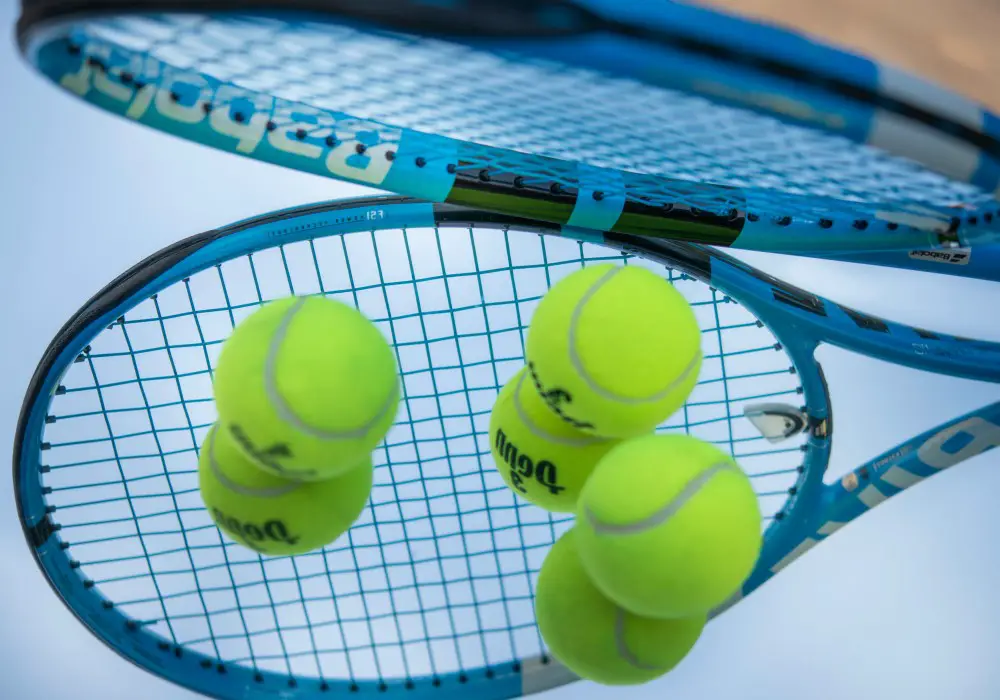Wondering what tennis ball is made of? Get to know the facts now.
What is a tennis ball made of? A tennis ball is made of layers consisting of a rubber material enclosing a hollow gas often nitrogen gas. The rubber material is then covered with a layer of wool for the high end tennis balls but nylon case can also work. Pressureless tennis ball layers consists of several layers of rubber material enclosed in a woolen felt. The outside tennis ball layer is colored yellow or green.
Tennis Ball Facts
| Tennis Ball Material Properties | Characteristics |
| Tennis Ball Materials | Rubber Wool Gas (Nitrogen or air) |
| Tennis Ball Weight | 1.98-2.10 ounces or 56.0-59.4 g. |
| Circumference of a Tennis Ball | 8.07-8.48 inches or 20.55-21.55 cm. |
| Diameter of a Tennis Ball | 2.57-2.70 inches or 6.54-6.86 cm. |
| Tennis Ball Pressure | 14-16psi |
| Forward Deformation | 0.220-0.290 inches Or 0.559-0.737 cm |
| Return Deformation | 0.315-0.425 inches Or 0.800-1.080 cm |
| Tennis Ball Bounce | At height of 254 cm or 100 inches Bounce range is 135-147cm Or 53-58 inches |
History Of Tennis Ball
International Tennis Federation
Tennis ball looks a simple ball but the process of manufacturing a tennis ball is complex. Besides, there are specific standards laid down by the International Tennis Federation concerning a high end tennis ball that must be met by manufacturers.
First Time Tennis Was Played
Tennis game was first played in the 1870s. At that time, tennis game was considered a royal game and was commonly known as lawn tennis. Lawn tennis balls were originally made of pure rubber.
The core of lawn tennis ball consisted of rubber layer, so it was a hard pressureless tennis ball. However, due to frequent wearing of the rubber the outside was cover with a layer of leather or wool to extends its durability.
Invention Of Pressurized Tennis Balls
The cover was frequently replaced but helped extend the durability of the ball up to about 1-2 years. It was until 1995 when the pressurized tennis balls were invented by Tretorn, a ball that is now popular in modern tennis history.
More softer, or low compression, tennis balls were invented by Tretorn in 1960. The softer tennis balls had a much reduced speed to enhance tennis skills development.
Invention Of Pressureless Tennis Balls
In 1983, Tretorn invented the pressureless tennis balls that had a performance almost comparable to the pressurized tennis balls that were invented in the 1960.
These modern day pressureless tennis ball is still in use to date amidst few modifications. Yellow color became official tennis ball color in 1972.
Tennis Ball Material Properties
Tennis Ball Materials Types
The main materials that are used in the making of tennis balls are;
- Rubber
- Wool
- Gas (Nitrogen), for making pressurized tennis balls
Vulcanized Rubber
A vulcanized processed rubber material is used to make tennis ball layers of rubber material. The layered rubber material can completely fill the core to result in a pressureless tennis ball. However, a hollow core encased by rubber material forms the pressurized tennis ball.
Air-filled Inner Core Of Pressurized Tennis Balls
The hollow part of the pressurized tennis ball is often filled with gas. Commonly used gas for tennis balls is nitrogen gas or air. The pressure of the gas in a new tennis balls ranges from 14 psi to 16 psi.
Over time, the gas leaks to the outside environment and can result in a ball being flat. That is why pressurized tennis balls are also stored in pressurized cans to extend the shelf life of the ball after it has been manufactured.
Tennis Ball Outer Covering
Traditional lawn tennis ball had an outer cover protecting the rubber material as leather or nylon. However, modern day tennis ball cover is made of a woolen material. Besides, based on the ITF standards, tennis balls should be colored yellow for better visibility.
Tennis Ball Weight
According to the International Tennis Federation Guidelines after accounting for all the materials used in making a tennis ball, a tennis ball weight must be within the range of 1.98-2.10 ounces or 56.0-59.4 g.
Any ball weighing bellow or above the standard weight cannot pass the quality check and cannot be approved for use in major tournaments such as Grand Slam, WTA, and ATP.
Circumference Of A Tennis Ball
A circumference of a tennis ball must be within the range of 8.07-8.48 inches, or 20.55-21.55 cm. The diameter of a tennis ball as stated by the ITF standards must be within the range of 2.57-2.70 inches, or 6.54-6.86 cm.
How To Make A Tennis Ball
With a clear idea of the characteristics of material properties of a tennis ball, it is evident that manufacturing a tennis ball is not quite easy. Specialized machines are used in processing the tennis balls following a process till the end.
11 Key Processes Involved in Making A Tennis Ball
Process 1: Crushing Of Materials
Rubber material is crushed to form sheets or layers.
Process 2: Sheets Cutting
Often, the rubber sheets are often large. The sheets are cut into pieces known as slugs.
Process 3: Molding Of Slug
The prepared slug is then molded. The mold create about half hollow core size.
Process 4: Joining Of The Half Pieces
The half pieces are glued together. Two halves are glued together to form a circular core that is hollow on the inside.
Process 5: Core Pressurization
The hollow inner core gets pumped in with gas such as nitrogen until the inside ball pressure ranges about 14-16psi. The pressure is what makes the ball bouncy.
Process 6: Preparation Of Felt
Felt in tennis is the outer cover that protects the insider rubber layer. Felts are made in half circular hollow shape.
Process 7: Gluing Of Felt Onto Rubber
Two halves of woven woolen felt are glued round the circular rubber to now form a complete ball.
Process 8: Curing
Curing is done to the felt to ensure that the felt effectively adheres to the rubber material
Process 9: Logo Design
The ball is now ready and the manufacturer design the company’s logo on the tennis ball
Process 10: Testing
The ball is tested to meet the ITF approval standards.
Process 11: Packaging
Tennis meeting the ITF standards are packed in pressurized cans. The packaging cans have pressure equivalent to the inner core tennis ball pressure to bring about equilibrium environment and prevent tennis ball from losing its pressure.
How Are Tennis Balls Pressurized?
Tennis ball are pressurized using an automated pressure pump. Most of the inside tennis balls are filled with gas such as nitrogen gas. So, the pump is connected to a container full of nitrogen gas or air as the air source.
Using a thin tube, the tube is inserted through the rubber material. Using a pressure gauge, pressure is pumped into the ball until the standard range is attained.
As soon as the tennis ball has been pressurized the pressure tube nozzle is ejected and that place sealed to prevent the pressurized air from escaping. The ball is then immediately inserted in a pressurized can with an equal pressure to bring about an equilibrium environment to prevent pressure loss.
What Makes A Tennis Ball Bounce?
A tennis ball bounces because of its material of construction including rubber and gas, the ball shape, and kinetic energy.
Rubber Material
Naturally, rubber material is bouncy in nature. It is because the chemical structure of rubber consists of intertwining of the rubber causing them to easily compress when pressure is applied and regain its shape when pressure is released. The resultant movement is bouncy.
Gas
For pressurized tennis ball, the ball is filled with gas that is often nitrogen gas. Gas is light weight. So, it easily moves. Thus, when the rubber hits the ground, the gas inside the ball makes its lighter and have much more aerodynamics to make it bounce further.
Shape
Tennis ball are circular in shape. A circular shape easily initiates a bounce than any other shape. As the rubber material hits a surface such as a tennis court, the round shape further enhances the bouncing capabilities of the ball.
Kinetic Energy
Kinetic energy is the energy in motion. Once a ball is hit, or thrown up in air, kinetic energy is activated. The energy makes the ball moves. Combined with other tennis ball properties, the ball easily bounces off when it lands on a surface.
Conclusion
What is a tennis made of include layers of rubber material, outer woven woolen felt colored yellow in most balls, and an air-filled interior for the pressurized tennis balls. Tennis balls layers are specially made to meet the ITF standards. Pressurizing of tennis balls involves using a pressure pump with a gauge. It is worth noting that what makes tennis ball bounce is the ball’s material composition.
Related Articles
Who Has Won All 4 Grand Slams In The Same Year?
Where Do Female Tennis Players Keep The Ball?


